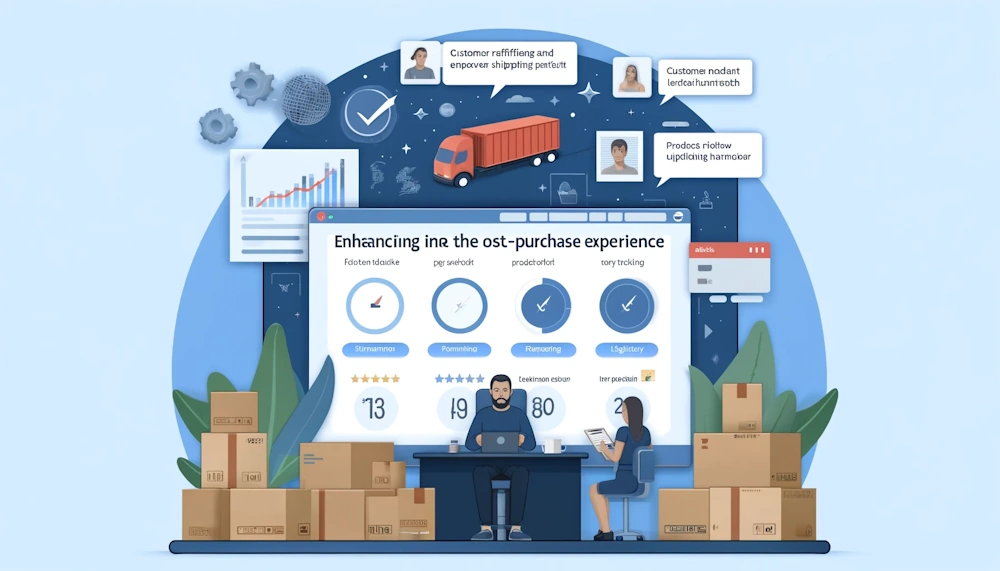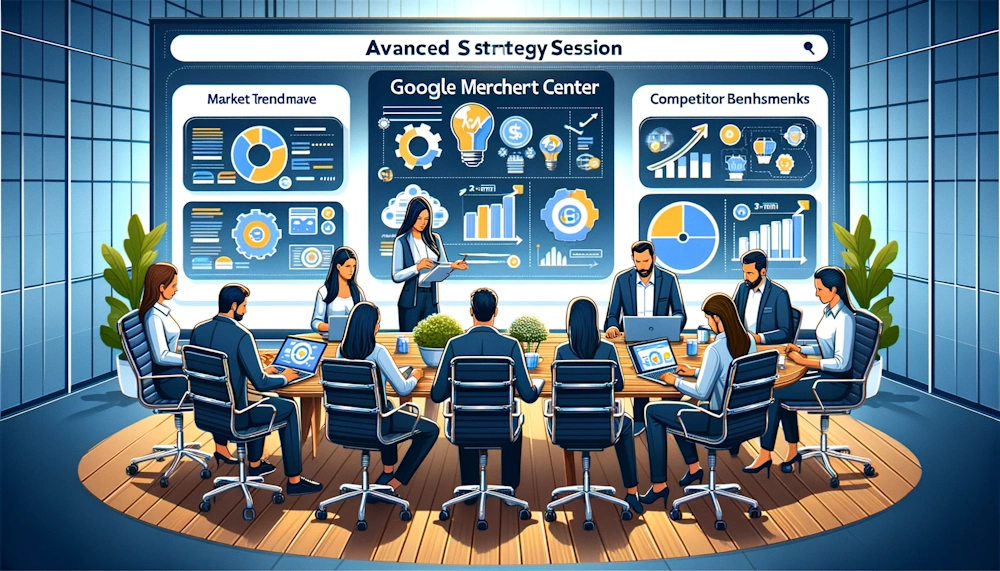Google Merchant Center Challenges: A Guide for eCommerce Success

The correct setup of Google Merchant Center is essential for eCommerce businesses aiming to thrive in the digital marketplace. Despite being perceived as a challenging platform, particularly for managing product listings and adhering to Google’s policies, it remains a crucial tool for online visibility and sales growth. This guide is crafted to help digital marketing managers, business owners, and in-house marketing teams overcome common Merchant Center challenges and integrate Google Merchant Center effectively into their marketing strategies, with an emphasis on maintaining a balance between informative content and offering practical solutions as a PPC agency.
Key Takeaways
- Understanding Google Merchant Center is essential for eCommerce success, and mastering it can lead to significant growth by enhancing product visibility and customer reach.
- Regularly optimising product listings and leveraging analytics within Google Merchant Center can drive sales and improve the overall effectiveness of marketing campaigns.
- Overcoming common challenges such as data feed errors, international market nuances, and staying abreast of Google’s evolving policies are crucial for maintaining a successful presence on the platform.
- Integrating Google Merchant Center with broader marketing strategies, including PPC, SEO, and seasonal promotions, can create a cohesive and effective approach to online sales.
- Enhancing the post-purchase experience through Google Merchant Center, such as encouraging customer reviews and implementing remarketing techniques, can lead to increased customer loyalty and repeat business.
Merchant Center Challenges: Mastering Google Merchant Center for Ecommerce Growth
Understanding the Basics of Google Merchant Center
To truly harness the power of Google Merchant Center (GMC), you must first grasp its core purpose: it’s the hub where your product data feeds into Google’s ecosystem, enabling shoppers to find your items through Google Shopping. Start by ensuring your product data is comprehensive and accurate, as this is the foundation of your success on the platform.
Google Merchant Center acts as a bridge between your eCommerce store and potential customers. It’s essential to familiarise yourself with the interface, the requirements for product feeds, and the various attributes that define your products. Here’s a quick checklist to get you started:
- Verify and claim your website URL.
- Set up your tax and shipping settings.
- Understand the required and optional product data attributes.
- Learn about product categories and how they affect search visibility.
Remember, consistency in your product data not only helps with visibility but also builds trust with your customers.
Once you’ve mastered these basics, you’ll be well on your way to leveraging GMC for increased traffic and sales. Keep in mind that regular maintenance of your product listings is crucial to stay relevant and competitive.
Optimising Product Listings for Maximum Visibility (Merchant Center Challenges:)
To ensure your products stand out in the crowded digital marketplace, strategic optimisation of your product listings is crucial. Start by refining your product titles and descriptions. Use relevant keywords that not only resonate with your target audience but also align with the search queries they are likely to use. Remember, clarity and relevance are your allies here.
Crafting compelling product narratives and incorporating high-quality images can significantly enhance the appeal of your listings. Consider the power of storytelling to connect with potential buyers on an emotional level.
Next, focus on the pricing strategy. Competitive pricing can be a game-changer, but it’s not just about being the cheapest. Experiment with different pricing models and promotions to find the sweet spot that attracts customers while maintaining profitability. Here’s a quick checklist to guide you:
- Evaluate your pricing against competitors regularly.
- Test promotional offers like discounts, bundles, or free shipping.
- Monitor the performance of different pricing strategies and adjust accordingly.
Lastly, don’t overlook the importance of reviews and ratings. Encourage satisfied customers to leave feedback, as positive reviews can significantly boost your product’s visibility and credibility. Keep in mind that a proactive approach to customer service can preempt negative reviews and turn potential detractors into advocates.
Leveraging Analytics to Drive Sales
To truly harness the power of analytics in driving sales, you must first identify the key performance indicators (KPIs) that align with your business objectives. Focus on metrics that directly impact revenue, such as conversion rate, average order value (AOV), and customer acquisition cost (CAC). By analysing these metrics, you can pinpoint areas for improvement and optimise your strategies accordingly.
Remember, data is the key to ecommerce success. It reveals the story behind customer interactions and transactional trends, guiding your decisions with precision.
Consider incorporating advanced technologies like AI to elevate your analytics. Look for tools that can provide deeper insights, predicting customer behavior and personalising the shopping experience. This integration of technology ensures you’re not just keeping pace, but moving with the trends.
Finally, set clear goals and match them with relevant KPIs to measure progress. For instance:
- Goal: Increase online sales by 20% in the next six months.
- KPIs: Total sales revenue, conversion rate, AOV.
- Goal: Boost website traffic by 30% in three months.
- KPIs: Unique website visitors, page views, bounce rate.
By regularly reviewing these metrics, you can adjust your strategies in real-time, ensuring your eCommerce platform is always optimised for growth.
Overcoming Common Google Merchant Center Challenges
Dealing with Data Feed Errors and Disapprovals
When you encounter data feed errors and disapprovals, it’s crucial to act swiftly to minimise disruptions in your product listings. Start by reviewing Google’s product data specifications; this ensures you understand the exact requirements for your product listings. Common issues include incorrect pricing, inadequate product identifiers, and non-compliant images.
Data quality is paramount in Google Merchant Center. To streamline the error resolution process, consider the following steps:
- Verify that all required attributes are present and correctly formatted.
- Check for accuracy in pricing and availability to prevent mismatches.
- Utilise Google’s diagnostics tab to identify and rectify issues promptly.
Remember, consistency in your product data not only helps in resolving current issues but also prevents future disapprovals.
Once you’ve addressed the initial errors, implement a routine check-up schedule. Regular monitoring and updating of your product feed are essential to maintaining a healthy presence on Google Shopping. By taking a proactive approach, you can turn potential setbacks into opportunities for optimising your eCommerce strategy.
International Market – Google Merchant Center Challenges:
When expanding your eCommerce operations globally, you’re not just dealing with a new audience, but an entirely different playing field. Mastering local market dynamics is crucial; conduct in-depth research to grasp the competitive landscape, cultural nuances, and consumer expectations, tailoring your approach to each unique market.
Partner with a shipping company well-versed in the customs regulations and documentation of your target countries. Set realistic expectations for international delivery times, including customs clearance periods. Adjust your pricing strategy to reflect local market conditions, considering taxes, import duties, and competitor pricing. Moreover, familiarise yourself with the most popular payment methods in different regions to streamline the checkout process for your international customers.
Adhering to import-export regulations is non-negotiable. Keep detailed records of all transactions, as they are essential for compliance and may be required during audits. Implementing global SEO practices will further enhance your visibility across borders.
Lastly, consider the following steps to ensure a smooth international expansion:
- Hire local experts for market-specific insights and strategies.
- Investigate local shipping and logistics complexities.
- Regularly update your knowledge of Google’s evolving policies to stay compliant.
Staying Updated with Google’s Evolving Policies
Staying abreast of Google’s evolving policies is essential. Keep your finger on the pulse of updates to ensure your product listings remain compliant and competitive. Regularly review the Google Merchant Center guidelines and adjust your strategies accordingly.
As Google introduces new features or adjusts its algorithms, these changes can significantly impact your visibility and sales. Proactive adaptation is key to maintaining your edge.
To streamline this process, consider the following steps:
- Set up Google alerts for policy updates and feature releases.
- Schedule monthly reviews of your Google Merchant Center account.
- Join eCommerce forums and subscribe to newsletters for insider insights.
- Attend webinars and online training sessions offered by Google.
Remember, what worked yesterday may not suffice tomorrow. Embrace change and let it propel your eCommerce journey forward.
Merchant Center Challenges: Integration with Your Marketing Strategy
Aligning Google Shopping Campaigns with Business Goals
To truly harness the power of Google Shopping campaigns, you must first anchor them to your overarching business objectives. Start by setting clear, measurable goals that align with your company’s growth aspirations. Whether it’s increasing online sales by a specific percentage, expanding market share, or enhancing customer retention, these targets will guide your campaign strategy.
Next, define the Key Performance Indicators (KPIs) that will serve as your compass. For instance:
- Goal: Increase online sales by 20% in the next six months.
- KPIs: Total sales revenue, conversion rate, average order value.
With your goals and KPIs in place, allocate your budget wisely. Consider factors like business size, revenue, and labor availability. Remember, the most profitable online retailers often spend a smaller percentage of their revenue on marketing due to their established presence.
It’s essential to review and adjust your campaigns regularly. Data is your ally; let it inform your decisions. If a product launch underperforms or a campaign misses the mark, be ready to pivot. Regular monitoring of your KPIs ensures that your Google Shopping campaigns remain aligned with your business goals, making adjustments as necessary for optimal performance.
Creating Synergy with PPC and SEO Efforts (Merchant Center Challenges)
To truly excel in the digital marketplace, you must master the art of synchronising your Google ads PPC and SEO strategies. Boldly bridging the gap between paid and organic search can significantly amplify your online presence. A London PPC agency specialising in eCommerce can provide expert PPC management, ensuring your Google Adwords PPC campaigns complement your SEO efforts seamlessly.
By conducting a thorough PPC audit, you can identify opportunities to enhance your ad performance and better align with your SEO objectives. This strategic alignment is crucial for maximising ROI and driving sustainable growth.
Consider the following steps to create synergy:
- Analyse keyword performance across both PPC and SEO to identify overlap and gaps.
- Use insights from your PPC data to inform your SEO content strategy.
- Collaborate with a PPC eCommerce agency to refine targeting and bidding strategies.
- Ensure messaging consistency across Google advertising agencies‘ campaigns and organic content.
Remember, a PPC ad agency is not just about managing ads; it’s about crafting a narrative that resonates with your audience. Whether you’re working with a PPC agency or managing in-house, the goal is to create a cohesive strategy that leverages the strengths of both channels. As an eCommerce PPC expert, you know the importance of detailed tracking and adjustments. Regularly review your approach, and don’t hesitate to seek the expertise of Google ads agencies for a fresh perspective.
Utilising Google Merchant Center for Seasonal Promotions
As you gear up for the spring shopping season, it’s crucial to leverage the Google Merchant Center to its fullest potential. Capitalise on seasonal trends by updating your product listings with seasonal keywords, eye-catching images, and special offers that resonate with the festive mood. Remember, shoppers are looking for deals that align with the season’s spirit.
- Start by reviewing historical sales data to identify top-performing products during similar past seasons.
- Adjust your bids for seasonal campaigns to ensure your products are prominently displayed.
- Create exclusive seasonal collections within your Merchant Center to simplify the shopping experience.
By thoughtfully curating your promotions, you can create a sense of urgency and exclusivity that entices customers to choose your offerings over competitors’.
Lastly, don’t forget to utilise insights tools like Merchant Center Next and the Google & YouTube app on Shopify. These platforms can help you harness AI-powered campaigns to find and capture new opportunities for seasonal promotions. Stay agile and responsive to market trends to maintain a competitive edge throughout the season.
Merchant Center Challenges: Enhancing the Post-Purchase Experience through Google Merchant Center
Encouraging Customer Reviews and Ratings
In eCom, your customers’ voices are a powerful tool for growth. Encourage your patrons to share their experiences by making the review process as seamless as possible. A positive review can significantly influence potential buyers, with 77% of customers reading reviews before making a purchase.
Consider these strategies to boost customer reviews:
- Simplify the review submission process on your website.
- Send follow-up emails post-purchase inviting customers to leave a review.
- Offer incentives for customers who take the time to write a review.
Remember, authenticity is key. Genuine customer feedback, whether positive or negative, provides valuable insights and fosters trust. Address negative reviews promptly and constructively; this not only improves your product offerings but also demonstrates your commitment to customer satisfaction.
By integrating customer reviews into your Google Merchant Center strategy, you not only enhance your product listings but also build a community of engaged customers who feel valued and heard.
Implementing Effective Remarketing Techniques (Merchant Center Challenges)
To truly harness the power of Google Merchant Center for your eCommerce business, you must master the art of remarketing. Remarketing is not just about reaching out; it’s about re-engaging with purpose. By targeting previous visitors who have interacted with your site but did not make a purchase, you can increase the likelihood of conversion through tailored messaging and offers.
When implementing remarketing strategies, consider the customer journey. Use the insights gleaned from analytics to segment your audience based on behavior and preferences. This allows for more personalised and effective communication.
Remarketing campaigns should be dynamic and responsive to user actions. For instance, if a customer abandoned a cart, send a reminder email with a special offer to incentivise the completion of the purchase. Here’s a simple checklist to ensure your remarketing efforts are on point:
- Review your audience lists regularly to keep them fresh and relevant.
- Create compelling ad copy that resonates with the target segment.
- Test different ad formats and placements to find what works best.
- Monitor campaign performance and adjust bids and budgets accordingly.
Remember, the goal is to make past visitors feel remembered and valued, not bombarded. By striking the right balance, you can turn potential losses into loyal customers.
Providing Comprehensive Product Information
To truly excel with Google Merchant Center, you must ensure that your product information is as comprehensive as possible. Provide detailed descriptions, high-quality images, and specifications to help your products stand out. This not only aids in better visibility but also instills confidence in potential buyers.
Remember, the more information you provide, the easier it is for customers to make an informed decision. Include usage instructions, care tips, and any other relevant information that could influence a purchase. A well-informed customer is more likely to convert and less likely to return an item.
By enriching your product listings with thorough information, you’re not just selling a product; you’re providing a solution and an experience.
Consider creating a FAQ section for each product to address common queries. This proactive approach can significantly reduce customer support tickets and enhance the shopping experience.
Merchant Center Challenges: Advanced Tactics for Success
Adopting Local Inventory Ads for Physical Stores
In the age of online shopping, your physical store can still thrive by leveraging Local Inventory Ads (LIAs) through Google Merchant Center. LIAs bridge the gap between online browsing and in-store purchases, showcasing your available products to nearby customers searching on Google. To get started, ensure your inventory data is accurate and updated regularly. Here’s a simple checklist to guide you:
- Verify your business location with Google My Business.
- Sync your inventory management system with Google Merchant Center.
- Set up local product feeds, including prices and availability.
- Optimise product titles and descriptions for local relevance.
By adopting LIAs, you’re not just driving foot traffic; you’re creating a seamless omnichannel experience. Remember, multi-channel shoppers are likely to spend significantly more than those who shop through a single channel. Embrace this opportunity to connect with your community and boost in-store sales.
With the right strategy, Local Inventory Ads can transform your physical store into a dynamic player in the digital marketplace.
Exploring the Benefits of Google’s Buy on Google Feature (Merchant Center Challenges)
As you delve into the world of eCommerce, embracing the Buy on Google feature can be a game-changer for your business. This seamless shopping solution allows customers to purchase products directly from Google search results, fostering a frictionless path to conversion. Boldly step into this arena and you’ll find that the integration of Buy on Google with your online store can lead to increased sales and customer satisfaction.
To truly harness the power of this feature, consider conducting a thorough Google ads audit. This will help you identify areas of improvement and optimise your campaigns for better performance. Remember, an audit isn’t just a one-time task; it’s an ongoing process that keeps your strategy sharp and effective.
- Review your current Google Shopping campaigns
- Analyse the performance metrics
- Adjust bidding strategies and budgets
By regularly auditing your Google ads, you’re not only staying ahead of the competition but also ensuring that your products are showcased in the best possible light on Google’s vast shopping network.
Customising Shopping Experiences with Merchant Promotions
To truly stand out in the crowded digital marketplace, personalise your customers’ shopping experiences with Merchant Promotions. This powerful tool allows you to offer special deals and discounts directly within Google Shopping, capturing the attention of potential buyers at a critical decision-making point. Start by identifying the promotions that resonate most with your audience. Are they looking for free shipping, percentage discounts, or perhaps a free gift with purchase?
- Offer targeted promotions based on customer behavior
- Highlight exclusive deals to incentivise first-time buyers
- Create urgency with limited-time offers
By strategically using Merchant Promotions, you can increase the perceived value of your products and encourage more conversions. Remember, personalisation is key; tailor your promotions to reflect the preferences and past purchasing behavior of your customers. This not only enhances the shopping experience but also fosters loyalty and repeat business.
Embrace the power of Merchant Promotions to differentiate your brand and make your products irresistible. With thoughtful customisation, you can turn casual browsers into loyal customers.
Merchant Center Challenges: Conclusion
Mastering Google Merchant Center is essential for driving online sales and enhancing visibility on Google Shopping. While it may present its challenges, the rewards of a well-managed Merchant Center can be substantial. By staying informed, focusing on accurate product data, and leveraging integrations like Shed Suite’s Google Merchant Center feature, businesses can streamline the journey from product discovery to purchase. Remember, whether you’re a digital marketing manager, business owner, or part of an in-house marketing team, you don’t have to navigate these waters alone. As a PPC agency, we’re equipped to support you through these complexities, ensuring your eCommerce strategy is not only robust but also primed for success. Embrace the tools and strategies discussed, and watch your online shed sales—or any eCommerce venture—flourish.
Frequently Asked Questions
How can Google Merchant Center help increase my eCommerce sales?
Google Merchant Center enables your products to appear in Google Shopping searches, increasing visibility and simplifying the path from discovery to purchase for customers. By optimising your product listings and leveraging analytics, you can drive more targeted traffic to your store and boost sales.
What are the common challenges with Google Merchant Center and how can I overcome them?
Common challenges include data feed errors, disapprovals, and staying updated with Google’s evolving policies. Overcoming these challenges involves regularly auditing your product feeds, adhering to Google’s guidelines, and possibly seeking assistance from a PPC agency experienced in navigating these issues.
How does localisation impact my eCommerce strategy in international markets through Google Merchant Center?
Localisation is critical in international markets to ensure your product listings resonate with local audiences. This may involve translating and adapting your content, using local currency and measurements, and understanding local market trends. Hiring local experts can be beneficial for end-to-end market research and localised marketing strategies.
How can integrating Google Merchant Center with my marketing strategy improve performance?
Integrating Google Merchant Center with your overall marketing strategy helps align your Google Shopping campaigns with business goals, creates synergy with PPC and SEO efforts, and allows for effective seasonal promotions. This holistic approach ensures a consistent message across all channels and maximises your eCommerce potential.
What advanced tactics can I use in Google Merchant Center to enhance my eCommerce success?
Advanced tactics include adopting Local Inventory Ads for physical stores, exploring Google’s Buy on Google feature for a streamlined checkout process, and customising shopping experiences with Merchant Promotions. These tactics can help differentiate your brand and provide more value to your customers.
How can I optimise the post-purchase experience for my customers using Google Merchant Center?
Optimising the post-purchase experience can be achieved by encouraging customer reviews and ratings, implementing effective remarketing techniques, and providing comprehensive product information. This enhances customer satisfaction and loyalty, leading to repeat business and positive word-of-mouth.
Author
Search Blog
Free PPC Audit
Subscribe to our Newsletter
The Voices of Our Success: Your Words, Our Pride
Don't just take our word for it. With over 100+ five-star reviews, we let our work-and our satisfied clients-speak for us.
"We have been working with PPC Geeks for around 6 months and have found Mark and the team to be very impressive. Having worked with a few companies in this and similar sectors, I rate PPC Geeks as the strongest I have come across. They have taken time to understand our business, our market and competitors and supported us to devise a strategy to generate business. I value the expertise Mark and his team provide and trust them to make the best recommendations for the long-term."
~ Just Go, Alasdair Anderson




